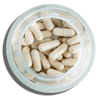Healing wounds faster, reducing scars, and fighting infections - bioactive nanomaterials are transforming tissue repair. These materials, engineered at the nanoscale (1-100 nanometers), actively support recovery in ways traditional methods can't. Here's why they matter:
- Faster Healing: Boost blood vessel growth, reduce inflammation, and speed up cell activity.
- Less Scarring: Better collagen organization and enzyme regulation for smoother recovery.
- Targeted Drug Delivery: Deliver medications directly to the wound while protecting against bacteria.
Key Stats and Facts:
- Diabetic wound recovery: 99% with nanomaterials vs. 77% with conventional care (in 21 days).
- Annual U.S. wound care cost: $25 billion.
- Materials like bioactive glass, chitosan, and silver nanoparticles combine antimicrobial, anti-inflammatory, and regenerative properties.
These advancements are reshaping medical treatments and hold promise for even better therapies in the future.
Nanobandage for Wound Healing
Main Advantages of Bioactive Nanomaterials
Bioactive nanomaterials bring a range of benefits to tissue healing, addressing challenges often seen in recovery. They help speed up healing, minimize scarring, and deliver medications directly to the target, outperforming traditional treatments.
Faster Healing Process
These materials improve wound healing by working in several important ways:
| Healing Mechanism | Impact on Recovery |
|---|---|
| Growth Factor Stimulation | Boosts VEGF production, encouraging blood vessel growth |
| Immune Response Modulation | Lowers inflammatory markers like IL-1 and TNF-α |
| Cell Activity Enhancement | Speeds up cell proliferation and migration |
Advanced nanocomposites have shown to significantly cut down recovery times, making them a game-changer in wound care [1].
Reduced Scar Formation
In addition to speeding up healing, these materials contribute to better tissue remodeling. For example, chitosan-based nanomaterials help organize collagen more effectively, guide skin cell migration, and regulate enzymes like matrix metalloproteinases, all of which are crucial for proper tissue repair [3].
Precise Drug Delivery
With stimuli-responsive systems, these materials ensure medications are delivered exactly where they’re needed, maintaining high concentrations at the site of injury. This precision allows for multi-functional therapies that not only control infections but also promote tissue regeneration by combining drug delivery with antimicrobial protection [2][3].
These targeted capabilities highlight the growing potential of bioactive nanomaterials in medical treatments and ongoing research.
Common Bioactive Nanomaterials in Healing
Building on the benefits of bioactive materials, certain nanomaterials take tissue healing to the next level by focusing on specific biological processes. Below are some notable examples that showcase how these materials work to improve healing outcomes.
Bioactive Glass Properties
Bioactive glass stands out as an effective scaffold for epithelial repair due to its ability to fight bacteria and encourage tissue regeneration. The 45S5 Bioglass formulation, in particular, is known for its ion-release properties that actively support healing. When applied to wounds, bioactive glass releases specific ions, each playing a role in the healing process:
| Ion Type | Healing Benefits |
|---|---|
| Cu⁺, Cu²⁺, Co²⁺, B³⁺, Zn²⁺ | Promote blood vessel growth (angiogenesis) |
| Ag⁺, Zn²⁺ | Decrease inflammation |
| Cu⁺, Cu²⁺, Ag⁺, Ga³⁺, Zn²⁺ | Provide antimicrobial effects |
Nano-fibrous bioactive glass dressings have shown remarkable results in wound care. They stimulate critical growth factors like vascular endothelial growth factor (VEGF) and basic fibroblast growth factor (bFGF), speeding up the healing process while also protecting against infections [3].
Chitosan Nanomaterial Functions
Chitosan-based nanomaterials play a versatile role in wound healing. Thanks to their positive charge, they disrupt bacterial membranes, offering strong antimicrobial protection without damaging surrounding tissue. Studies show that chitosan promotes cell proliferation, migration, and differentiation, all while allowing oxygen to pass through - an essential factor for healing [3]. Additionally, its biodegradable nature eliminates the need for manual removal, minimizing the risk of disturbing fragile, newly formed tissue.
Gold and Silver Nanoparticles
Metallic nanoparticles, such as gold and silver, bring unique advantages to the healing process. Silver nanoparticles are highly effective against bacteria, even targeting antibiotic-resistant strains by disrupting their cellular functions. Gold nanoparticles, on the other hand, help reduce inflammation by neutralizing reactive oxygen species and delivering treatments with precision. When incorporated into hydrogel dressings, these nanoparticles amplify both antibacterial and anti-inflammatory effects [1].
sbb-itb-4f17e23
How Nanomaterials Work
Bioactive nanomaterials bring a molecular-level advantage to healing, directly interacting with cells to create the perfect environment for regeneration. Let’s dive into how these materials work their magic.
Immune System Response
One way nanomaterials promote faster healing is by fine-tuning the immune response. They help shift macrophages from a pro-inflammatory (M1) state to an anti-inflammatory (M2) state, which is key to reducing inflammation and promoting repair [4].
Here’s how they influence the immune system:
| Mechanism | Effect on Immune System |
|---|---|
| Ion Release | Zinc (Zn²⁺) and silver (Ag⁺) ions lower inflammation. |
| Barrier Formation | Acts as a physical shield against immune cell infiltration. |
| Cytokine Regulation | Reduces inflammatory markers like IL-1 and TNF-α. |
| Growth Factor Support | Boosts VEGF production, essential for tissue repair. |
Cell Communication Effects
Nanomaterials enhance cell communication by activating genes involved in repair and strengthening gap junctions. This boosts the expression of critical repair-related proteins like vascular endothelial growth factor (VEGF), basic fibroblast growth factor (bFGF), and vascular cell adhesion protein (VCAM) [3].
Additionally, these materials act as physical bridges and signal amplifiers, creating an environment where cells can better coordinate repair processes. They also maintain a sterile microenvironment, ensuring the healing area stays free of harmful contaminants.
Protection Against Infection
Nanomaterials take a multi-pronged approach to safeguard against infection, ensuring tissue regeneration isn’t hindered:
-
Antimicrobial Action
Metal ions such as silver (Ag⁺), copper (Cu²⁺), and zinc (Zn²⁺) disrupt bacterial membranes and inhibit DNA replication. This broad-spectrum activity helps prevent the rise of antibiotic-resistant bacteria [3]. -
Oxidative Stress Management
By mimicking natural antioxidant enzymes, nanomaterials neutralize reactive oxygen species (ROS), protecting cells from oxidative damage during healing [4]. -
Sustained Protection
These materials release antimicrobial agents gradually, offering long-term protection. This is especially useful for chronic wounds that require extended care.
Medical Applications and Research
FDA-Approved Uses
Bioactive nanomaterials have found their way into advanced medical treatments, including wound dressings, bone grafting, and dental implant integration. These materials have shown potential to improve healing processes, although the precise quantitative benefits are still being studied. These approved uses pave the way for further advancements in tissue regeneration technologies.
New Research Developments
Researchers are pushing the boundaries with innovative applications like smart wound dressings, targeted drug delivery systems, and adaptive materials that interact seamlessly with tissue environments. These advancements aim to enhance tissue repair and regeneration, reinforcing the promise nanomaterials hold for future medical breakthroughs.
Links to Longevity Medicine
The intersection of nanomaterials and longevity medicine signals an exciting new chapter in tissue repair. By integrating cutting-edge nanomaterial research with longevity science, researchers are exploring solutions that align with MASI Longevity Science's focus on cellular repair and anti-aging therapies.
MASI supplements, crafted in Germany with premium ingredients and independently tested in Switzerland, reflect this commitment to supporting cellular health. Early studies suggest that combining nanomaterial-based therapies with cellular health supplements could create a synergistic effect, further advancing tissue regeneration. This comprehensive approach highlights a promising future for regenerative medicine and longevity science.
Conclusion: Impact of Bioactive Nanomaterials
Bioactive nanomaterials are changing the game in tissue healing and regenerative medicine. Their ability to speed up recovery and reduce scarring has set a new bar for patient care in various medical fields. These materials tackle traditional healing challenges with precision, promoting better cellular regeneration and targeted recovery.
As research and production methods improve, bioactive nanomaterials are paving the way for even more advanced and effective treatments. Their role in enhancing cellular health and optimizing healing processes marks a major step forward in regenerative medicine.
At MASI Longevity Science, we’re committed to harnessing these advancements. By combining nanotechnology with cellular health strategies, we're shaping a future where regenerative treatments are not only more effective but also less invasive. This approach reflects our dedication to advancing the possibilities of tomorrow’s therapies.
FAQs
What are the benefits of bioactive nanomaterials in tissue healing compared to traditional methods?
Bioactive nanomaterials bring a new edge to tissue healing, offering benefits that surpass those of traditional wound care methods. These materials are crafted to work at the cellular level, speeding up recovery, easing inflammation, and reducing scarring. By delivering precise therapeutic effects, they actively encourage tissue regeneration and improve the overall healing process.
Unlike standard treatments that primarily deal with external wound care, bioactive nanomaterials operate within the body, enhancing the natural healing mechanisms. This approach tackles common issues like prolonged recovery and inadequate tissue integration, presenting an exciting option for advancing wound care solutions.
Are there any risks or side effects associated with using bioactive nanomaterials for tissue healing?
While the article doesn't dive into the potential risks or side effects of using bioactive nanomaterials for tissue healing, these materials are generally engineered to support recovery by tackling issues like delayed healing and excessive scarring. For a deeper understanding of their safety profile, it's best to review scientific research or consult healthcare professionals who specialize in this field.
How do bioactive nanomaterials enhance tissue healing and support anti-aging therapies?
Bioactive nanomaterials are changing the game when it comes to tissue healing. They tackle some of the toughest challenges, like slow recovery, inflammation, and scarring, by working directly at the cellular level. These materials don't just passively sit in the body - they actively stimulate regeneration, speed up the healing process, and help minimize the formation of scar tissue. Plus, their ability to deliver treatments precisely where they're needed makes them a standout in modern medical applications.
When it comes to anti-aging, bioactive nanomaterials hold exciting potential. They support cellular repair and renewal - key factors in keeping tissues healthy and maintaining longevity. By enhancing the body’s natural ability to heal itself, these materials could open new doors for therapies designed to slow the aging process and boost overall vitality.




